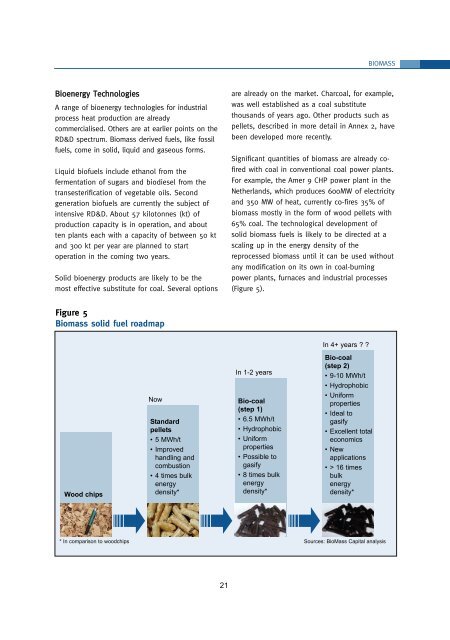Renewable Energy in Industrial Applications â an ... - Unido
Renewable Energy in Industrial Applications â an ... - Unido
Renewable Energy in Industrial Applications â an ... - Unido
Create successful ePaper yourself
Turn your PDF publications into a flip-book with our unique Google optimized e-Paper software.
BIOMASS<br />
Bioenergy Technologies<br />
A r<strong>an</strong>ge of bioenergy technologies for <strong>in</strong>dustrial<br />
process heat production are already<br />
commercialised. Others are at earlier po<strong>in</strong>ts on the<br />
RD&D spectrum. Biomass derived fuels, like fossil<br />
fuels, come <strong>in</strong> solid, liquid <strong>an</strong>d gaseous forms.<br />
Liquid biofuels <strong>in</strong>clude eth<strong>an</strong>ol from the<br />
fermentation of sugars <strong>an</strong>d biodiesel from the<br />
tr<strong>an</strong>sesterification of vegetable oils. Second<br />
generation biofuels are currently the subject of<br />
<strong>in</strong>tensive RD&D. About 57 kilotonnes (kt) of<br />
production capacity is <strong>in</strong> operation, <strong>an</strong>d about<br />
ten pl<strong>an</strong>ts each with a capacity of between 50 kt<br />
<strong>an</strong>d 300 kt per year are pl<strong>an</strong>ned to start<br />
operation <strong>in</strong> the com<strong>in</strong>g two years.<br />
Solid bioenergy products are likely to be the<br />
most effective substitute for coal. Several options<br />
are already on the market. Charcoal, for example,<br />
was well established as a coal substitute<br />
thous<strong>an</strong>ds of years ago. Other products such as<br />
pellets, described <strong>in</strong> more detail <strong>in</strong> Annex 2, have<br />
been developed more recently.<br />
Signific<strong>an</strong>t qu<strong>an</strong>tities of biomass are already cofired<br />
with coal <strong>in</strong> conventional coal power pl<strong>an</strong>ts.<br />
For example, the Amer 9 CHP power pl<strong>an</strong>t <strong>in</strong> the<br />
Netherl<strong>an</strong>ds, which produces 600MW of electricity<br />
<strong>an</strong>d 350 MW of heat, currently co-fires 35% of<br />
biomass mostly <strong>in</strong> the form of wood pellets with<br />
65% coal. The technological development of<br />
solid biomass fuels is likely to be directed at a<br />
scal<strong>in</strong>g up <strong>in</strong> the energy density of the<br />
reprocessed biomass until it c<strong>an</strong> be used without<br />
<strong>an</strong>y modification on its own <strong>in</strong> coal-burn<strong>in</strong>g<br />
power pl<strong>an</strong>ts, furnaces <strong>an</strong>d <strong>in</strong>dustrial processes<br />
(Figure 5).<br />
Figure 5<br />
Biomass solid fuel roadmap<br />
In 4+ years <br />
Wood chips<br />
Now<br />
St<strong>an</strong>dard<br />
pellets<br />
• 5 MWh/t<br />
• Improved<br />
h<strong>an</strong>dl<strong>in</strong>g <strong>an</strong>d<br />
combustion<br />
• 4 times bulk<br />
energy<br />
density*<br />
In 1-2 years<br />
Bio-coal<br />
(step 1)<br />
• 6.5 MWh/t<br />
• Hydrophobic<br />
• Uniform<br />
properties<br />
• Possible to<br />
gasify<br />
• 8 times bulk<br />
energy<br />
density*<br />
Bio-coal<br />
(step 2)<br />
• 9-10 MWh/t<br />
• Hydrophobic<br />
• Uniform<br />
properties<br />
• Ideal to<br />
gasify<br />
• Excellent total<br />
economics<br />
• New<br />
applications<br />
• > 16 times<br />
bulk<br />
energy<br />
density*<br />
* In comparison to woodchips Sources: BioMass Capital <strong>an</strong>alysis<br />
21

















